University of Tasmania: Nursing Teaching and Learning Essay (CNA632)
VerifiedAdded on 2022/10/13
|11
|3131
|22
Essay
AI Summary
This essay provides a comprehensive analysis of nursing teaching and learning, focusing on the attributes of 21st-century learners and how healthcare education has adapted to contemporary practices. It explores the importance of creativity, communication, critical thinking, global citizenship, and technology literacy in nursing education. The essay examines various learning strategies adopted in health education, including the use of audio-visual aids, interactive presentations, group learning, and the 4Cs of 21st-century skills. It also reflects on a recent learner practice-based program, highlighting its strengths in promoting competence and addressing challenges in healthcare. Furthermore, the essay discusses how a program could be constructed to reflect contemporary teaching and learning practices, emphasizing the need for modified assessment and the integration of learning with classwork. Finally, it explores relevant teaching and learning theories such as behaviorism and constructivism, which are applied in healthcare education. The essay concludes by emphasizing the need for quality practices and the development of essential skills in nursing education to meet the challenges of the modern healthcare environment.
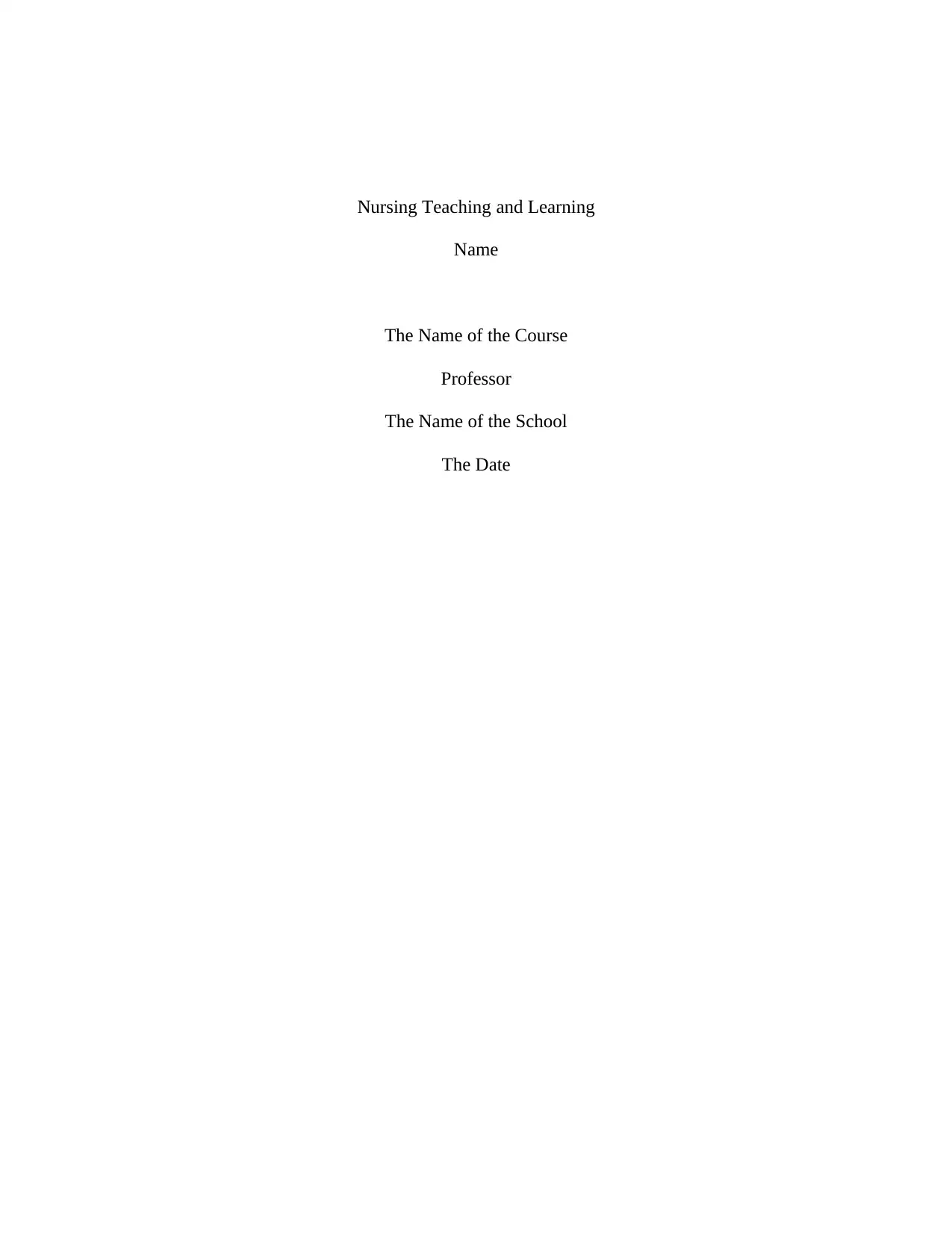
Nursing Teaching and Learning
Name
The Name of the Course
Professor
The Name of the School
The Date
Name
The Name of the Course
Professor
The Name of the School
The Date
Paraphrase This Document
Need a fresh take? Get an instant paraphrase of this document with our AI Paraphraser
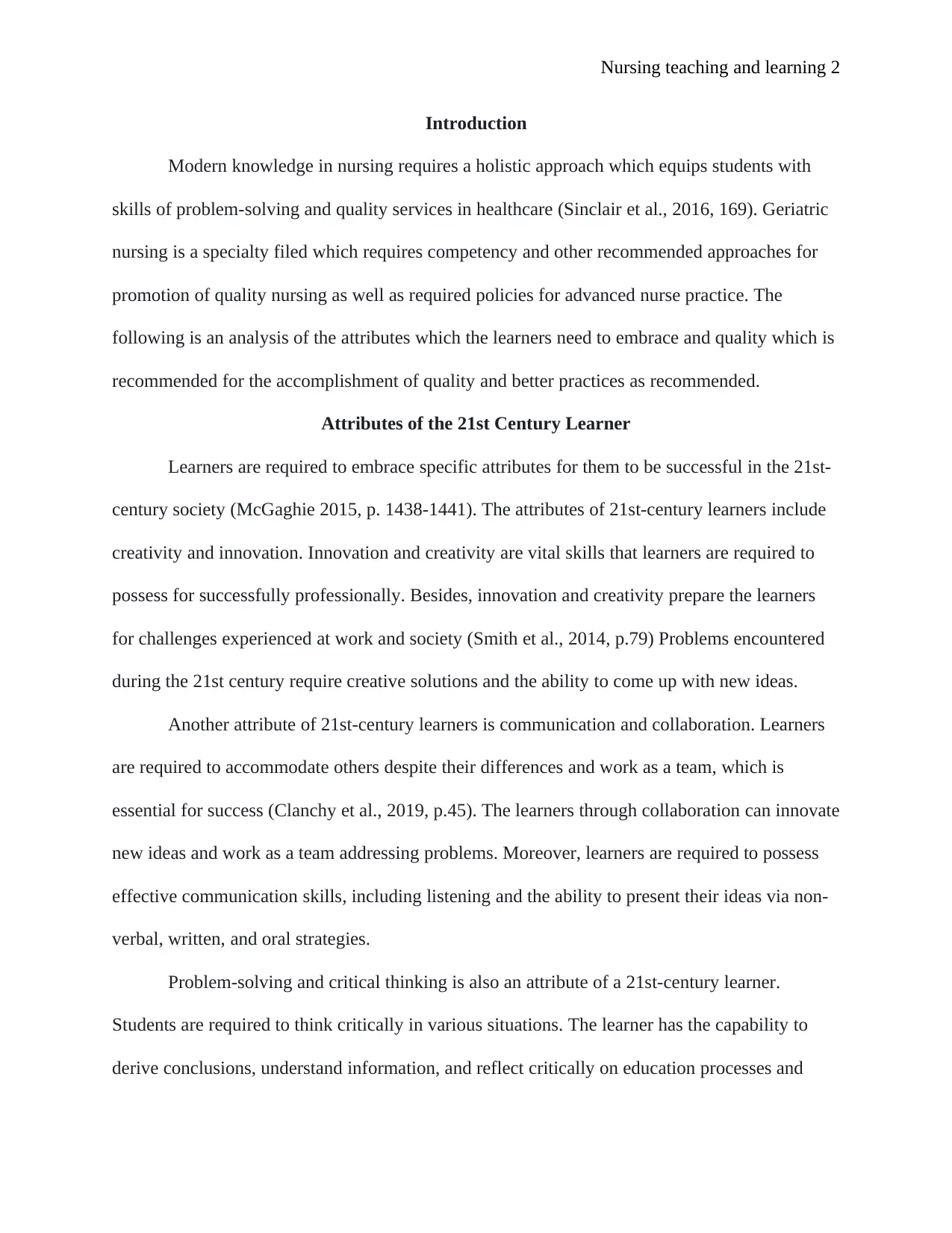
Nursing teaching and learning 2
Introduction
Modern knowledge in nursing requires a holistic approach which equips students with
skills of problem-solving and quality services in healthcare (Sinclair et al., 2016, 169). Geriatric
nursing is a specialty filed which requires competency and other recommended approaches for
promotion of quality nursing as well as required policies for advanced nurse practice. The
following is an analysis of the attributes which the learners need to embrace and quality which is
recommended for the accomplishment of quality and better practices as recommended.
Attributes of the 21st Century Learner
Learners are required to embrace specific attributes for them to be successful in the 21st-
century society (McGaghie 2015, p. 1438-1441). The attributes of 21st-century learners include
creativity and innovation. Innovation and creativity are vital skills that learners are required to
possess for successfully professionally. Besides, innovation and creativity prepare the learners
for challenges experienced at work and society (Smith et al., 2014, p.79) Problems encountered
during the 21st century require creative solutions and the ability to come up with new ideas.
Another attribute of 21st-century learners is communication and collaboration. Learners
are required to accommodate others despite their differences and work as a team, which is
essential for success (Clanchy et al., 2019, p.45). The learners through collaboration can innovate
new ideas and work as a team addressing problems. Moreover, learners are required to possess
effective communication skills, including listening and the ability to present their ideas via non-
verbal, written, and oral strategies.
Problem-solving and critical thinking is also an attribute of a 21st-century learner.
Students are required to think critically in various situations. The learner has the capability to
derive conclusions, understand information, and reflect critically on education processes and
Introduction
Modern knowledge in nursing requires a holistic approach which equips students with
skills of problem-solving and quality services in healthcare (Sinclair et al., 2016, 169). Geriatric
nursing is a specialty filed which requires competency and other recommended approaches for
promotion of quality nursing as well as required policies for advanced nurse practice. The
following is an analysis of the attributes which the learners need to embrace and quality which is
recommended for the accomplishment of quality and better practices as recommended.
Attributes of the 21st Century Learner
Learners are required to embrace specific attributes for them to be successful in the 21st-
century society (McGaghie 2015, p. 1438-1441). The attributes of 21st-century learners include
creativity and innovation. Innovation and creativity are vital skills that learners are required to
possess for successfully professionally. Besides, innovation and creativity prepare the learners
for challenges experienced at work and society (Smith et al., 2014, p.79) Problems encountered
during the 21st century require creative solutions and the ability to come up with new ideas.
Another attribute of 21st-century learners is communication and collaboration. Learners
are required to accommodate others despite their differences and work as a team, which is
essential for success (Clanchy et al., 2019, p.45). The learners through collaboration can innovate
new ideas and work as a team addressing problems. Moreover, learners are required to possess
effective communication skills, including listening and the ability to present their ideas via non-
verbal, written, and oral strategies.
Problem-solving and critical thinking is also an attribute of a 21st-century learner.
Students are required to think critically in various situations. The learner has the capability to
derive conclusions, understand information, and reflect critically on education processes and
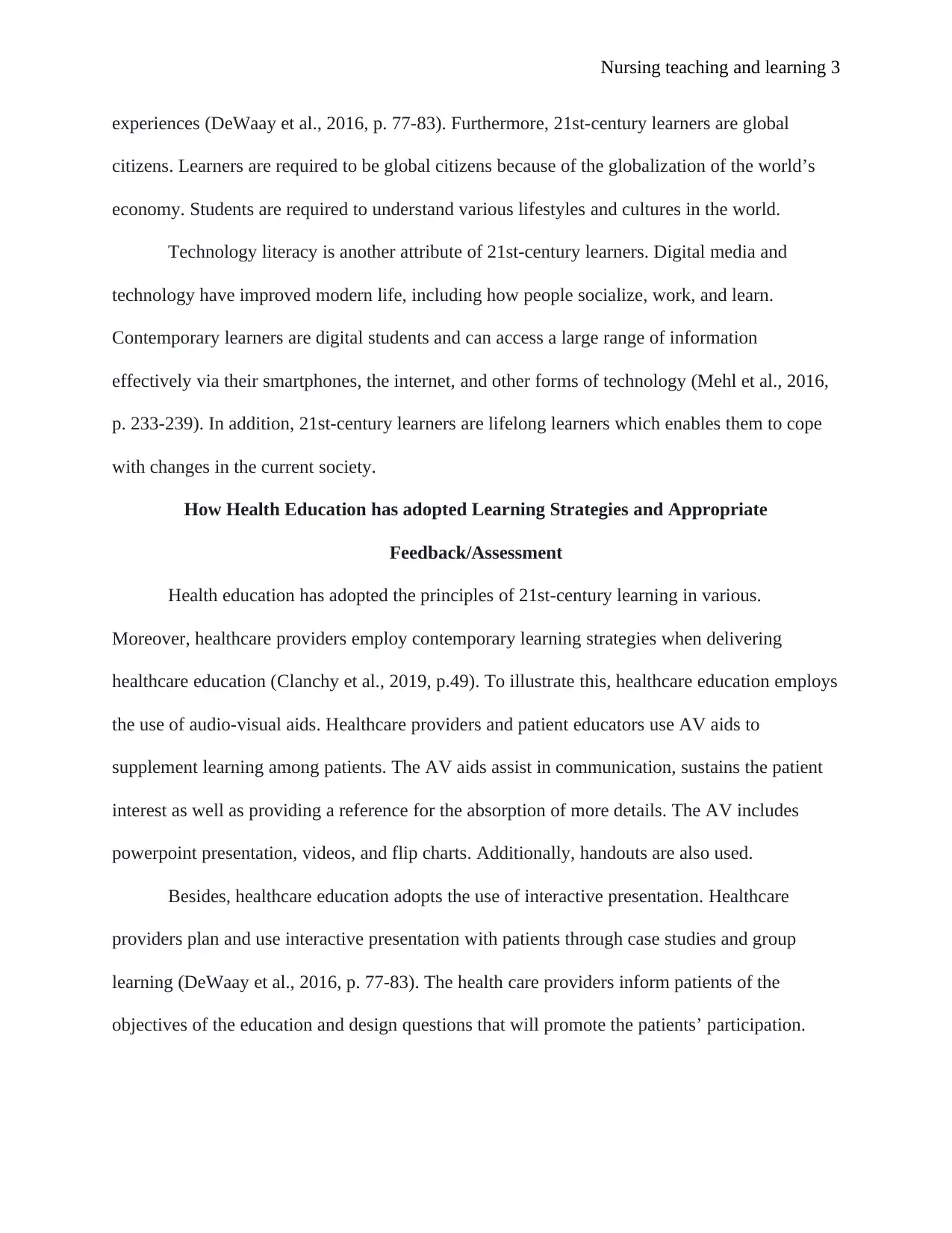
Nursing teaching and learning 3
experiences (DeWaay et al., 2016, p. 77-83). Furthermore, 21st-century learners are global
citizens. Learners are required to be global citizens because of the globalization of the world’s
economy. Students are required to understand various lifestyles and cultures in the world.
Technology literacy is another attribute of 21st-century learners. Digital media and
technology have improved modern life, including how people socialize, work, and learn.
Contemporary learners are digital students and can access a large range of information
effectively via their smartphones, the internet, and other forms of technology (Mehl et al., 2016,
p. 233-239). In addition, 21st-century learners are lifelong learners which enables them to cope
with changes in the current society.
How Health Education has adopted Learning Strategies and Appropriate
Feedback/Assessment
Health education has adopted the principles of 21st-century learning in various.
Moreover, healthcare providers employ contemporary learning strategies when delivering
healthcare education (Clanchy et al., 2019, p.49). To illustrate this, healthcare education employs
the use of audio-visual aids. Healthcare providers and patient educators use AV aids to
supplement learning among patients. The AV aids assist in communication, sustains the patient
interest as well as providing a reference for the absorption of more details. The AV includes
powerpoint presentation, videos, and flip charts. Additionally, handouts are also used.
Besides, healthcare education adopts the use of interactive presentation. Healthcare
providers plan and use interactive presentation with patients through case studies and group
learning (DeWaay et al., 2016, p. 77-83). The health care providers inform patients of the
objectives of the education and design questions that will promote the patients’ participation.
experiences (DeWaay et al., 2016, p. 77-83). Furthermore, 21st-century learners are global
citizens. Learners are required to be global citizens because of the globalization of the world’s
economy. Students are required to understand various lifestyles and cultures in the world.
Technology literacy is another attribute of 21st-century learners. Digital media and
technology have improved modern life, including how people socialize, work, and learn.
Contemporary learners are digital students and can access a large range of information
effectively via their smartphones, the internet, and other forms of technology (Mehl et al., 2016,
p. 233-239). In addition, 21st-century learners are lifelong learners which enables them to cope
with changes in the current society.
How Health Education has adopted Learning Strategies and Appropriate
Feedback/Assessment
Health education has adopted the principles of 21st-century learning in various.
Moreover, healthcare providers employ contemporary learning strategies when delivering
healthcare education (Clanchy et al., 2019, p.49). To illustrate this, healthcare education employs
the use of audio-visual aids. Healthcare providers and patient educators use AV aids to
supplement learning among patients. The AV aids assist in communication, sustains the patient
interest as well as providing a reference for the absorption of more details. The AV includes
powerpoint presentation, videos, and flip charts. Additionally, handouts are also used.
Besides, healthcare education adopts the use of interactive presentation. Healthcare
providers plan and use interactive presentation with patients through case studies and group
learning (DeWaay et al., 2016, p. 77-83). The health care providers inform patients of the
objectives of the education and design questions that will promote the patients’ participation.
⊘ This is a preview!⊘
Do you want full access?
Subscribe today to unlock all pages.

Trusted by 1+ million students worldwide
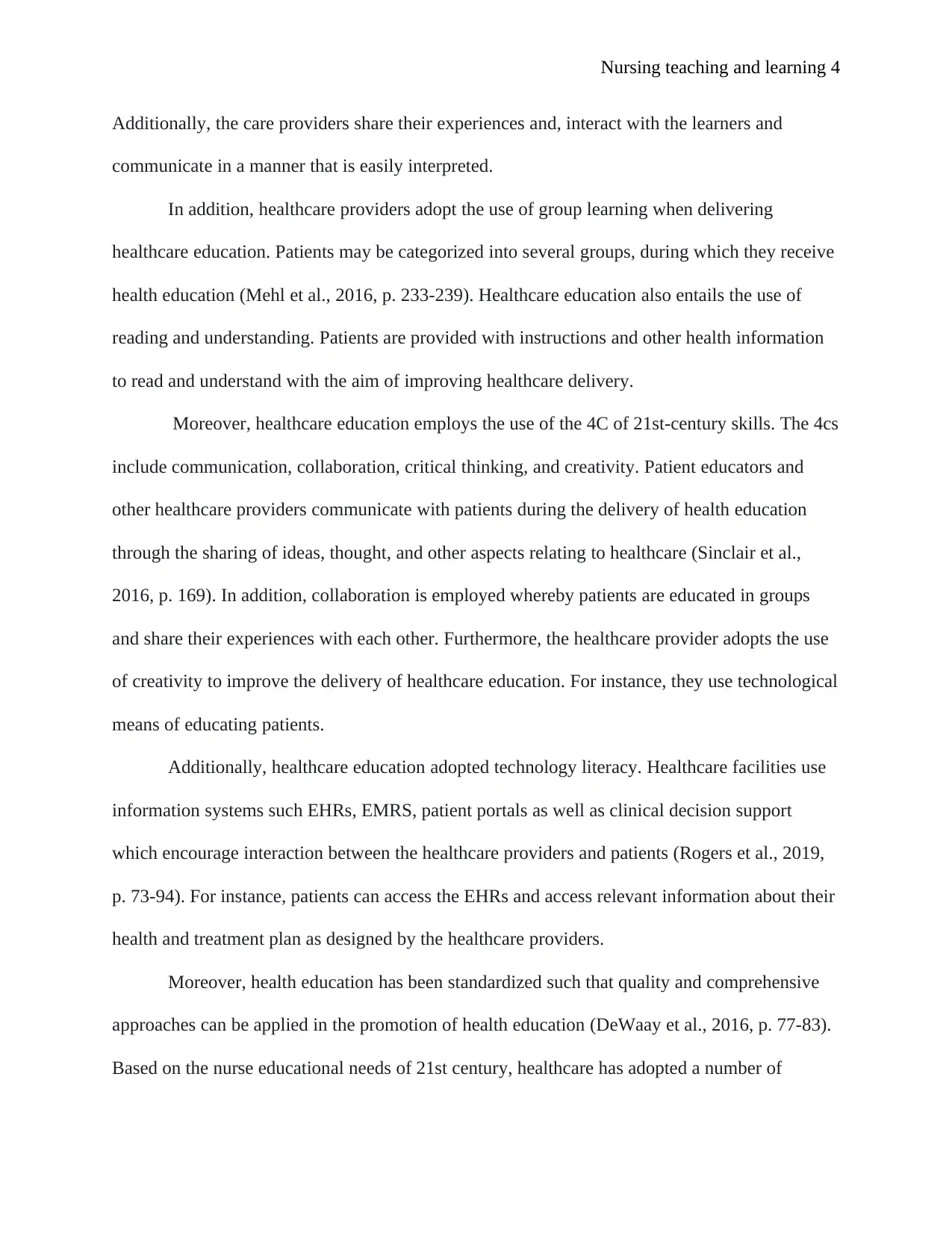
Nursing teaching and learning 4
Additionally, the care providers share their experiences and, interact with the learners and
communicate in a manner that is easily interpreted.
In addition, healthcare providers adopt the use of group learning when delivering
healthcare education. Patients may be categorized into several groups, during which they receive
health education (Mehl et al., 2016, p. 233-239). Healthcare education also entails the use of
reading and understanding. Patients are provided with instructions and other health information
to read and understand with the aim of improving healthcare delivery.
Moreover, healthcare education employs the use of the 4C of 21st-century skills. The 4cs
include communication, collaboration, critical thinking, and creativity. Patient educators and
other healthcare providers communicate with patients during the delivery of health education
through the sharing of ideas, thought, and other aspects relating to healthcare (Sinclair et al.,
2016, p. 169). In addition, collaboration is employed whereby patients are educated in groups
and share their experiences with each other. Furthermore, the healthcare provider adopts the use
of creativity to improve the delivery of healthcare education. For instance, they use technological
means of educating patients.
Additionally, healthcare education adopted technology literacy. Healthcare facilities use
information systems such EHRs, EMRS, patient portals as well as clinical decision support
which encourage interaction between the healthcare providers and patients (Rogers et al., 2019,
p. 73-94). For instance, patients can access the EHRs and access relevant information about their
health and treatment plan as designed by the healthcare providers.
Moreover, health education has been standardized such that quality and comprehensive
approaches can be applied in the promotion of health education (DeWaay et al., 2016, p. 77-83).
Based on the nurse educational needs of 21st century, healthcare has adopted a number of
Additionally, the care providers share their experiences and, interact with the learners and
communicate in a manner that is easily interpreted.
In addition, healthcare providers adopt the use of group learning when delivering
healthcare education. Patients may be categorized into several groups, during which they receive
health education (Mehl et al., 2016, p. 233-239). Healthcare education also entails the use of
reading and understanding. Patients are provided with instructions and other health information
to read and understand with the aim of improving healthcare delivery.
Moreover, healthcare education employs the use of the 4C of 21st-century skills. The 4cs
include communication, collaboration, critical thinking, and creativity. Patient educators and
other healthcare providers communicate with patients during the delivery of health education
through the sharing of ideas, thought, and other aspects relating to healthcare (Sinclair et al.,
2016, p. 169). In addition, collaboration is employed whereby patients are educated in groups
and share their experiences with each other. Furthermore, the healthcare provider adopts the use
of creativity to improve the delivery of healthcare education. For instance, they use technological
means of educating patients.
Additionally, healthcare education adopted technology literacy. Healthcare facilities use
information systems such EHRs, EMRS, patient portals as well as clinical decision support
which encourage interaction between the healthcare providers and patients (Rogers et al., 2019,
p. 73-94). For instance, patients can access the EHRs and access relevant information about their
health and treatment plan as designed by the healthcare providers.
Moreover, health education has been standardized such that quality and comprehensive
approaches can be applied in the promotion of health education (DeWaay et al., 2016, p. 77-83).
Based on the nurse educational needs of 21st century, healthcare has adopted a number of
Paraphrase This Document
Need a fresh take? Get an instant paraphrase of this document with our AI Paraphraser
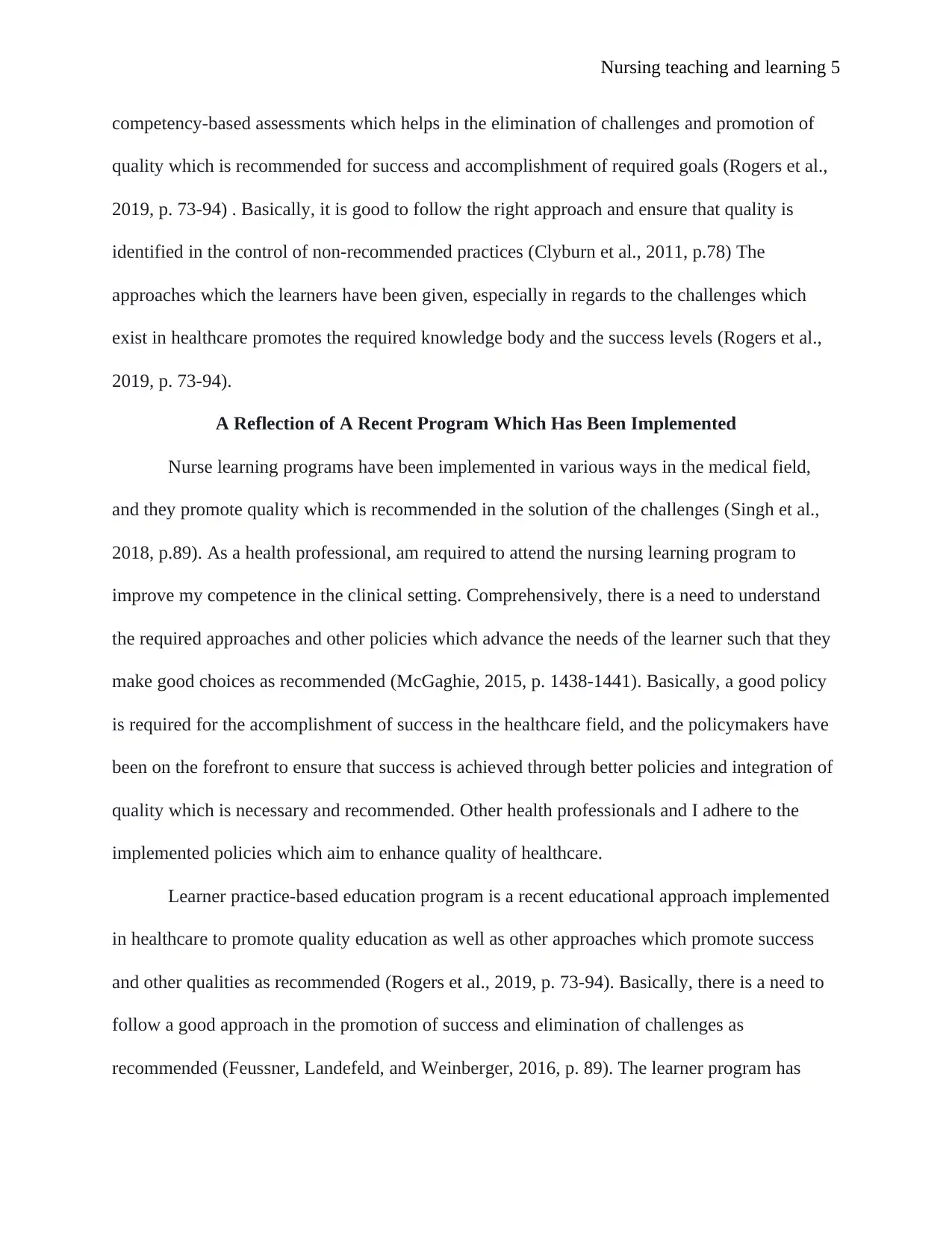
Nursing teaching and learning 5
competency-based assessments which helps in the elimination of challenges and promotion of
quality which is recommended for success and accomplishment of required goals (Rogers et al.,
2019, p. 73-94) . Basically, it is good to follow the right approach and ensure that quality is
identified in the control of non-recommended practices (Clyburn et al., 2011, p.78) The
approaches which the learners have been given, especially in regards to the challenges which
exist in healthcare promotes the required knowledge body and the success levels (Rogers et al.,
2019, p. 73-94).
A Reflection of A Recent Program Which Has Been Implemented
Nurse learning programs have been implemented in various ways in the medical field,
and they promote quality which is recommended in the solution of the challenges (Singh et al.,
2018, p.89). As a health professional, am required to attend the nursing learning program to
improve my competence in the clinical setting. Comprehensively, there is a need to understand
the required approaches and other policies which advance the needs of the learner such that they
make good choices as recommended (McGaghie, 2015, p. 1438-1441). Basically, a good policy
is required for the accomplishment of success in the healthcare field, and the policymakers have
been on the forefront to ensure that success is achieved through better policies and integration of
quality which is necessary and recommended. Other health professionals and I adhere to the
implemented policies which aim to enhance quality of healthcare.
Learner practice-based education program is a recent educational approach implemented
in healthcare to promote quality education as well as other approaches which promote success
and other qualities as recommended (Rogers et al., 2019, p. 73-94). Basically, there is a need to
follow a good approach in the promotion of success and elimination of challenges as
recommended (Feussner, Landefeld, and Weinberger, 2016, p. 89). The learner program has
competency-based assessments which helps in the elimination of challenges and promotion of
quality which is recommended for success and accomplishment of required goals (Rogers et al.,
2019, p. 73-94) . Basically, it is good to follow the right approach and ensure that quality is
identified in the control of non-recommended practices (Clyburn et al., 2011, p.78) The
approaches which the learners have been given, especially in regards to the challenges which
exist in healthcare promotes the required knowledge body and the success levels (Rogers et al.,
2019, p. 73-94).
A Reflection of A Recent Program Which Has Been Implemented
Nurse learning programs have been implemented in various ways in the medical field,
and they promote quality which is recommended in the solution of the challenges (Singh et al.,
2018, p.89). As a health professional, am required to attend the nursing learning program to
improve my competence in the clinical setting. Comprehensively, there is a need to understand
the required approaches and other policies which advance the needs of the learner such that they
make good choices as recommended (McGaghie, 2015, p. 1438-1441). Basically, a good policy
is required for the accomplishment of success in the healthcare field, and the policymakers have
been on the forefront to ensure that success is achieved through better policies and integration of
quality which is necessary and recommended. Other health professionals and I adhere to the
implemented policies which aim to enhance quality of healthcare.
Learner practice-based education program is a recent educational approach implemented
in healthcare to promote quality education as well as other approaches which promote success
and other qualities as recommended (Rogers et al., 2019, p. 73-94). Basically, there is a need to
follow a good approach in the promotion of success and elimination of challenges as
recommended (Feussner, Landefeld, and Weinberger, 2016, p. 89). The learner program has
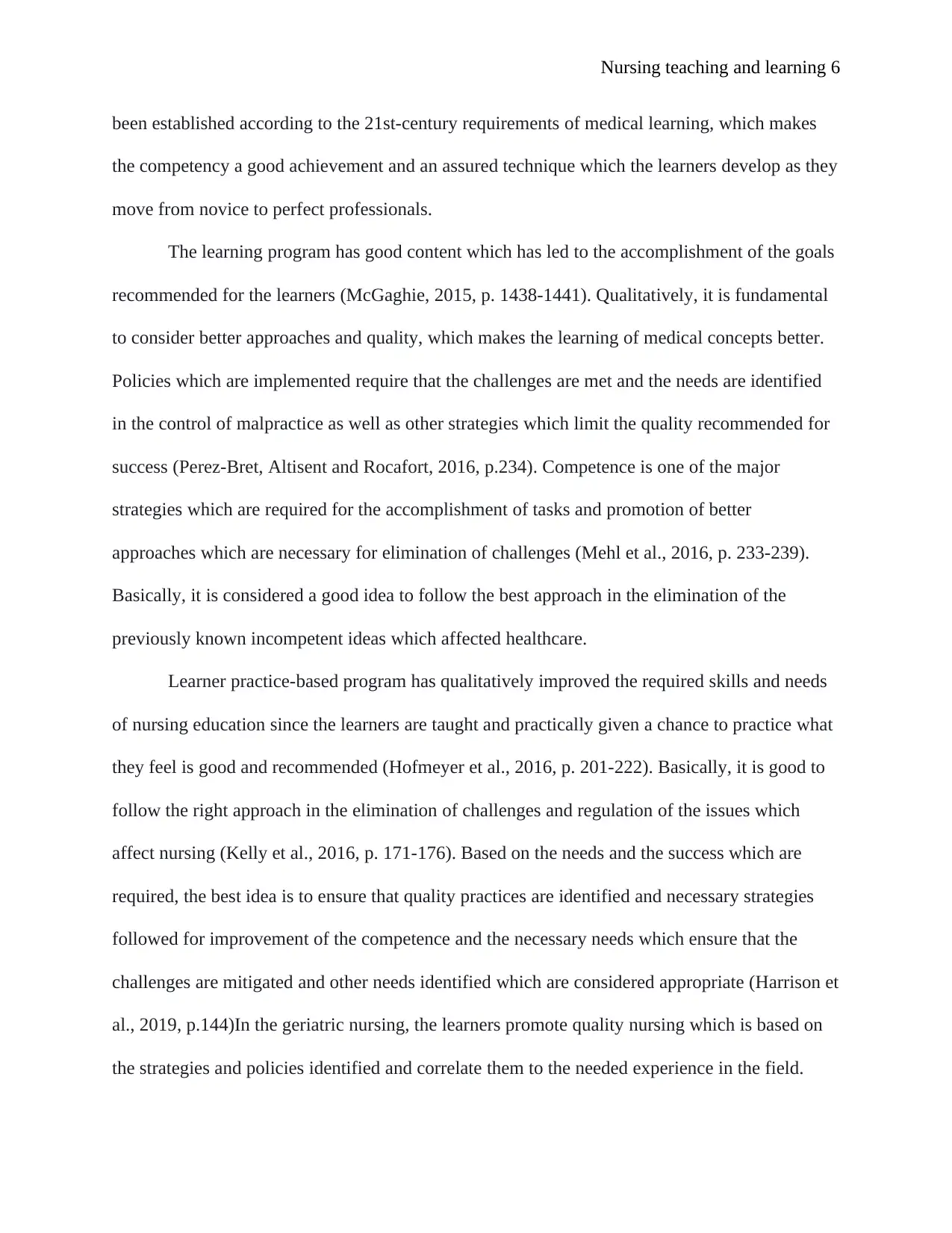
Nursing teaching and learning 6
been established according to the 21st-century requirements of medical learning, which makes
the competency a good achievement and an assured technique which the learners develop as they
move from novice to perfect professionals.
The learning program has good content which has led to the accomplishment of the goals
recommended for the learners (McGaghie, 2015, p. 1438-1441). Qualitatively, it is fundamental
to consider better approaches and quality, which makes the learning of medical concepts better.
Policies which are implemented require that the challenges are met and the needs are identified
in the control of malpractice as well as other strategies which limit the quality recommended for
success (Perez-Bret, Altisent and Rocafort, 2016, p.234). Competence is one of the major
strategies which are required for the accomplishment of tasks and promotion of better
approaches which are necessary for elimination of challenges (Mehl et al., 2016, p. 233-239).
Basically, it is considered a good idea to follow the best approach in the elimination of the
previously known incompetent ideas which affected healthcare.
Learner practice-based program has qualitatively improved the required skills and needs
of nursing education since the learners are taught and practically given a chance to practice what
they feel is good and recommended (Hofmeyer et al., 2016, p. 201-222). Basically, it is good to
follow the right approach in the elimination of challenges and regulation of the issues which
affect nursing (Kelly et al., 2016, p. 171-176). Based on the needs and the success which are
required, the best idea is to ensure that quality practices are identified and necessary strategies
followed for improvement of the competence and the necessary needs which ensure that the
challenges are mitigated and other needs identified which are considered appropriate (Harrison et
al., 2019, p.144)In the geriatric nursing, the learners promote quality nursing which is based on
the strategies and policies identified and correlate them to the needed experience in the field.
been established according to the 21st-century requirements of medical learning, which makes
the competency a good achievement and an assured technique which the learners develop as they
move from novice to perfect professionals.
The learning program has good content which has led to the accomplishment of the goals
recommended for the learners (McGaghie, 2015, p. 1438-1441). Qualitatively, it is fundamental
to consider better approaches and quality, which makes the learning of medical concepts better.
Policies which are implemented require that the challenges are met and the needs are identified
in the control of malpractice as well as other strategies which limit the quality recommended for
success (Perez-Bret, Altisent and Rocafort, 2016, p.234). Competence is one of the major
strategies which are required for the accomplishment of tasks and promotion of better
approaches which are necessary for elimination of challenges (Mehl et al., 2016, p. 233-239).
Basically, it is considered a good idea to follow the best approach in the elimination of the
previously known incompetent ideas which affected healthcare.
Learner practice-based program has qualitatively improved the required skills and needs
of nursing education since the learners are taught and practically given a chance to practice what
they feel is good and recommended (Hofmeyer et al., 2016, p. 201-222). Basically, it is good to
follow the right approach in the elimination of challenges and regulation of the issues which
affect nursing (Kelly et al., 2016, p. 171-176). Based on the needs and the success which are
required, the best idea is to ensure that quality practices are identified and necessary strategies
followed for improvement of the competence and the necessary needs which ensure that the
challenges are mitigated and other needs identified which are considered appropriate (Harrison et
al., 2019, p.144)In the geriatric nursing, the learners promote quality nursing which is based on
the strategies and policies identified and correlate them to the needed experience in the field.
⊘ This is a preview!⊘
Do you want full access?
Subscribe today to unlock all pages.

Trusted by 1+ million students worldwide
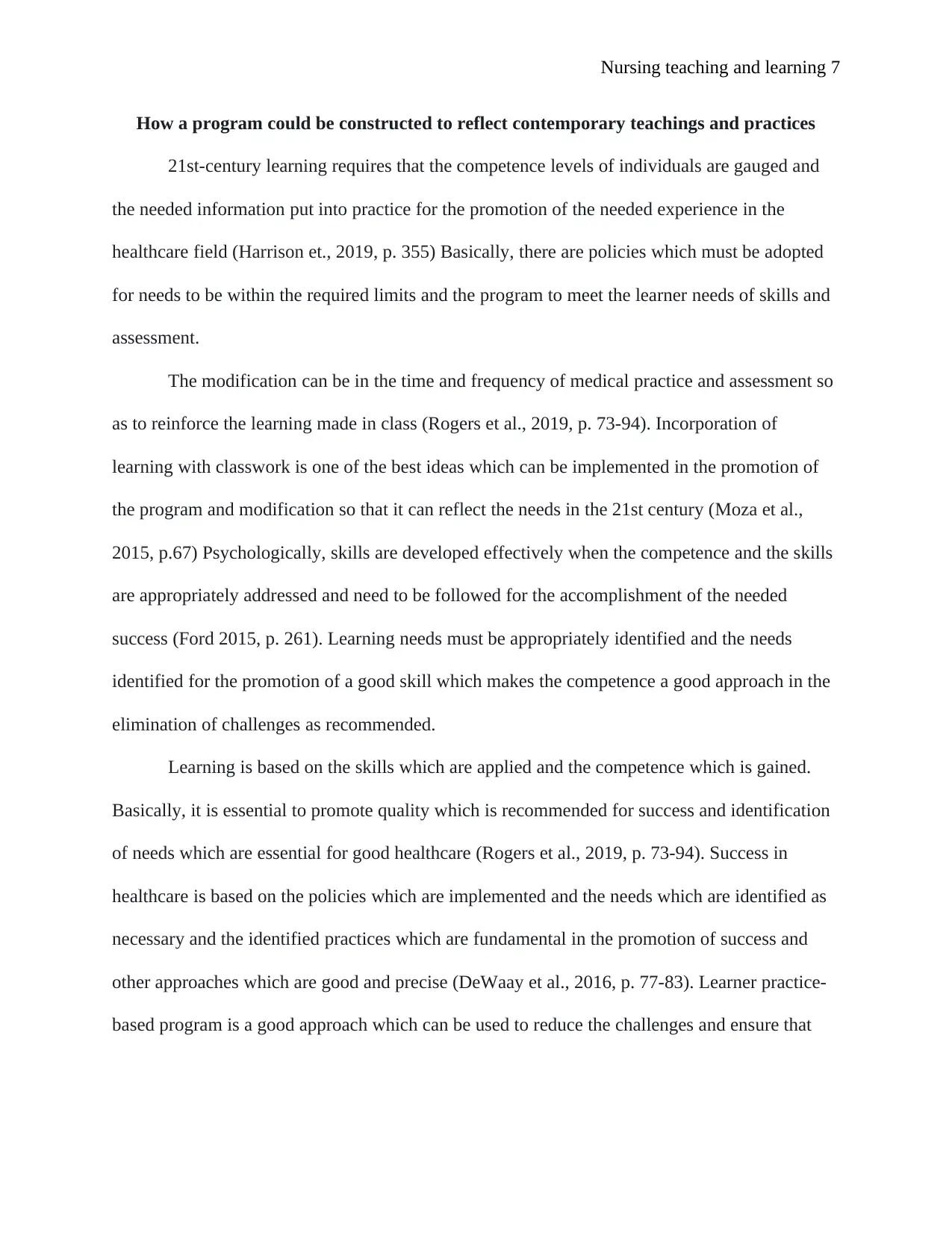
Nursing teaching and learning 7
How a program could be constructed to reflect contemporary teachings and practices
21st-century learning requires that the competence levels of individuals are gauged and
the needed information put into practice for the promotion of the needed experience in the
healthcare field (Harrison et., 2019, p. 355) Basically, there are policies which must be adopted
for needs to be within the required limits and the program to meet the learner needs of skills and
assessment.
The modification can be in the time and frequency of medical practice and assessment so
as to reinforce the learning made in class (Rogers et al., 2019, p. 73-94). Incorporation of
learning with classwork is one of the best ideas which can be implemented in the promotion of
the program and modification so that it can reflect the needs in the 21st century (Moza et al.,
2015, p.67) Psychologically, skills are developed effectively when the competence and the skills
are appropriately addressed and need to be followed for the accomplishment of the needed
success (Ford 2015, p. 261). Learning needs must be appropriately identified and the needs
identified for the promotion of a good skill which makes the competence a good approach in the
elimination of challenges as recommended.
Learning is based on the skills which are applied and the competence which is gained.
Basically, it is essential to promote quality which is recommended for success and identification
of needs which are essential for good healthcare (Rogers et al., 2019, p. 73-94). Success in
healthcare is based on the policies which are implemented and the needs which are identified as
necessary and the identified practices which are fundamental in the promotion of success and
other approaches which are good and precise (DeWaay et al., 2016, p. 77-83). Learner practice-
based program is a good approach which can be used to reduce the challenges and ensure that
How a program could be constructed to reflect contemporary teachings and practices
21st-century learning requires that the competence levels of individuals are gauged and
the needed information put into practice for the promotion of the needed experience in the
healthcare field (Harrison et., 2019, p. 355) Basically, there are policies which must be adopted
for needs to be within the required limits and the program to meet the learner needs of skills and
assessment.
The modification can be in the time and frequency of medical practice and assessment so
as to reinforce the learning made in class (Rogers et al., 2019, p. 73-94). Incorporation of
learning with classwork is one of the best ideas which can be implemented in the promotion of
the program and modification so that it can reflect the needs in the 21st century (Moza et al.,
2015, p.67) Psychologically, skills are developed effectively when the competence and the skills
are appropriately addressed and need to be followed for the accomplishment of the needed
success (Ford 2015, p. 261). Learning needs must be appropriately identified and the needs
identified for the promotion of a good skill which makes the competence a good approach in the
elimination of challenges as recommended.
Learning is based on the skills which are applied and the competence which is gained.
Basically, it is essential to promote quality which is recommended for success and identification
of needs which are essential for good healthcare (Rogers et al., 2019, p. 73-94). Success in
healthcare is based on the policies which are implemented and the needs which are identified as
necessary and the identified practices which are fundamental in the promotion of success and
other approaches which are good and precise (DeWaay et al., 2016, p. 77-83). Learner practice-
based program is a good approach which can be used to reduce the challenges and ensure that
Paraphrase This Document
Need a fresh take? Get an instant paraphrase of this document with our AI Paraphraser
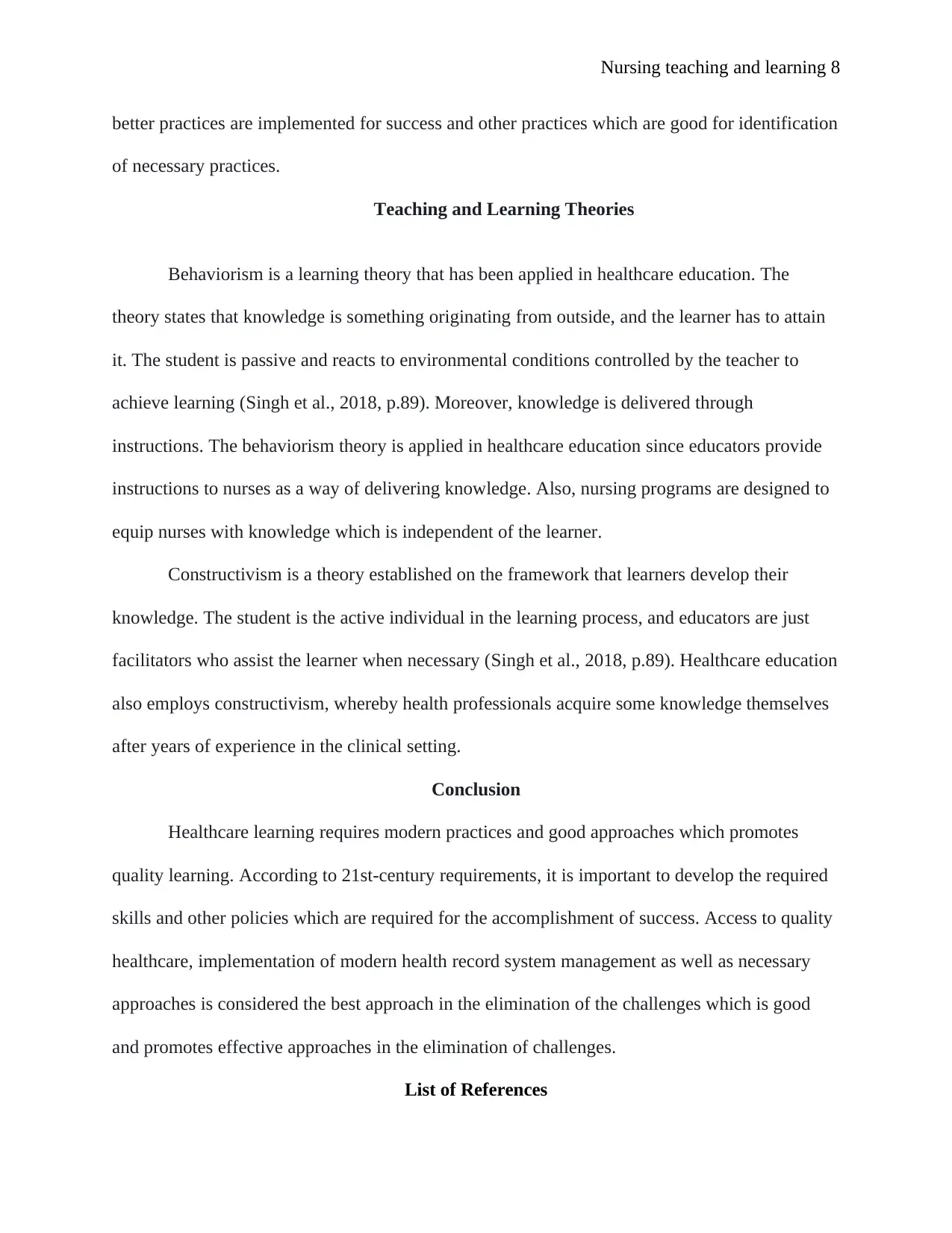
Nursing teaching and learning 8
better practices are implemented for success and other practices which are good for identification
of necessary practices.
Teaching and Learning Theories
Behaviorism is a learning theory that has been applied in healthcare education. The
theory states that knowledge is something originating from outside, and the learner has to attain
it. The student is passive and reacts to environmental conditions controlled by the teacher to
achieve learning (Singh et al., 2018, p.89). Moreover, knowledge is delivered through
instructions. The behaviorism theory is applied in healthcare education since educators provide
instructions to nurses as a way of delivering knowledge. Also, nursing programs are designed to
equip nurses with knowledge which is independent of the learner.
Constructivism is a theory established on the framework that learners develop their
knowledge. The student is the active individual in the learning process, and educators are just
facilitators who assist the learner when necessary (Singh et al., 2018, p.89). Healthcare education
also employs constructivism, whereby health professionals acquire some knowledge themselves
after years of experience in the clinical setting.
Conclusion
Healthcare learning requires modern practices and good approaches which promotes
quality learning. According to 21st-century requirements, it is important to develop the required
skills and other policies which are required for the accomplishment of success. Access to quality
healthcare, implementation of modern health record system management as well as necessary
approaches is considered the best approach in the elimination of the challenges which is good
and promotes effective approaches in the elimination of challenges.
List of References
better practices are implemented for success and other practices which are good for identification
of necessary practices.
Teaching and Learning Theories
Behaviorism is a learning theory that has been applied in healthcare education. The
theory states that knowledge is something originating from outside, and the learner has to attain
it. The student is passive and reacts to environmental conditions controlled by the teacher to
achieve learning (Singh et al., 2018, p.89). Moreover, knowledge is delivered through
instructions. The behaviorism theory is applied in healthcare education since educators provide
instructions to nurses as a way of delivering knowledge. Also, nursing programs are designed to
equip nurses with knowledge which is independent of the learner.
Constructivism is a theory established on the framework that learners develop their
knowledge. The student is the active individual in the learning process, and educators are just
facilitators who assist the learner when necessary (Singh et al., 2018, p.89). Healthcare education
also employs constructivism, whereby health professionals acquire some knowledge themselves
after years of experience in the clinical setting.
Conclusion
Healthcare learning requires modern practices and good approaches which promotes
quality learning. According to 21st-century requirements, it is important to develop the required
skills and other policies which are required for the accomplishment of success. Access to quality
healthcare, implementation of modern health record system management as well as necessary
approaches is considered the best approach in the elimination of the challenges which is good
and promotes effective approaches in the elimination of challenges.
List of References
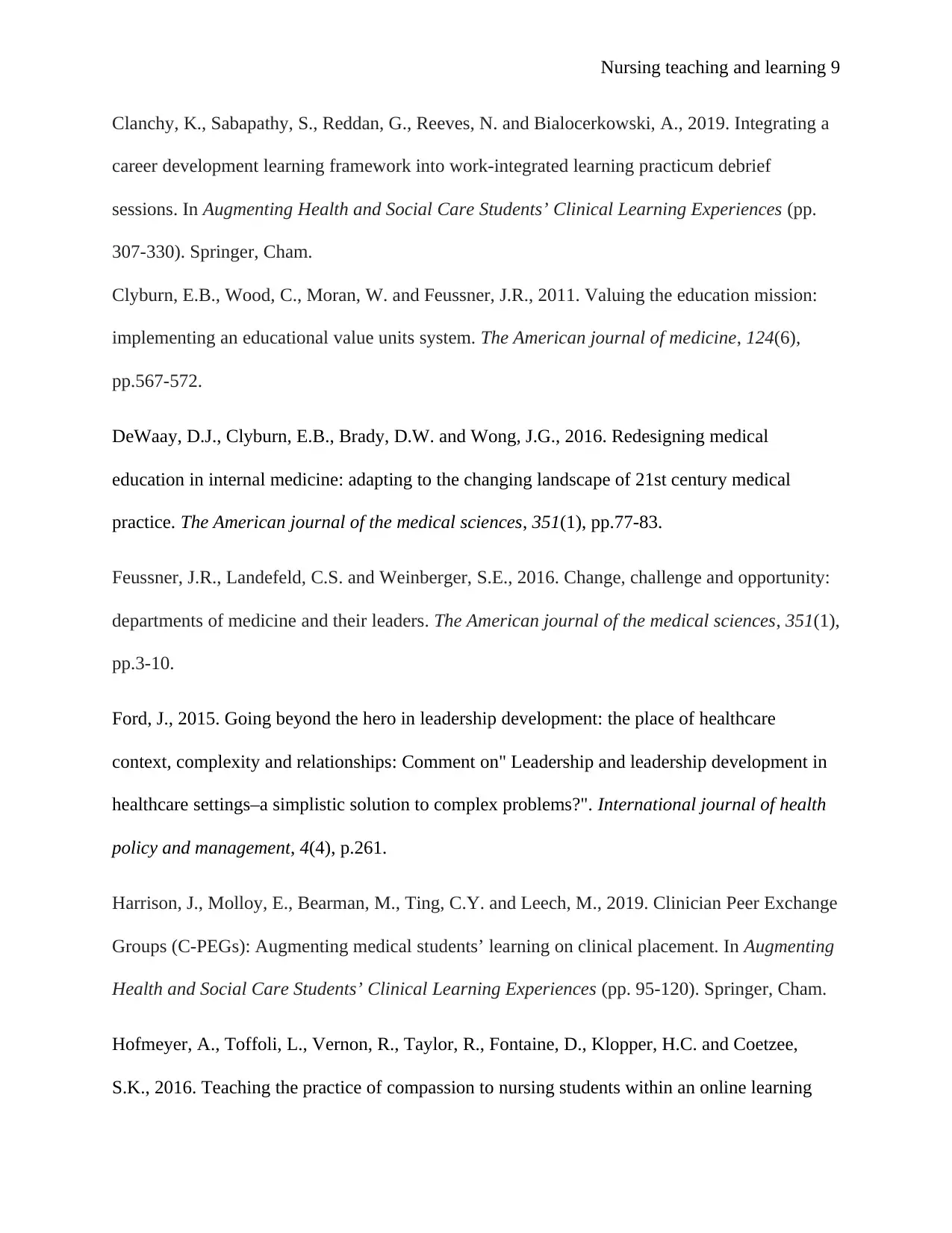
Nursing teaching and learning 9
Clanchy, K., Sabapathy, S., Reddan, G., Reeves, N. and Bialocerkowski, A., 2019. Integrating a
career development learning framework into work-integrated learning practicum debrief
sessions. In Augmenting Health and Social Care Students’ Clinical Learning Experiences (pp.
307-330). Springer, Cham.
Clyburn, E.B., Wood, C., Moran, W. and Feussner, J.R., 2011. Valuing the education mission:
implementing an educational value units system. The American journal of medicine, 124(6),
pp.567-572.
DeWaay, D.J., Clyburn, E.B., Brady, D.W. and Wong, J.G., 2016. Redesigning medical
education in internal medicine: adapting to the changing landscape of 21st century medical
practice. The American journal of the medical sciences, 351(1), pp.77-83.
Feussner, J.R., Landefeld, C.S. and Weinberger, S.E., 2016. Change, challenge and opportunity:
departments of medicine and their leaders. The American journal of the medical sciences, 351(1),
pp.3-10.
Ford, J., 2015. Going beyond the hero in leadership development: the place of healthcare
context, complexity and relationships: Comment on" Leadership and leadership development in
healthcare settings–a simplistic solution to complex problems?". International journal of health
policy and management, 4(4), p.261.
Harrison, J., Molloy, E., Bearman, M., Ting, C.Y. and Leech, M., 2019. Clinician Peer Exchange
Groups (C-PEGs): Augmenting medical students’ learning on clinical placement. In Augmenting
Health and Social Care Students’ Clinical Learning Experiences (pp. 95-120). Springer, Cham.
Hofmeyer, A., Toffoli, L., Vernon, R., Taylor, R., Fontaine, D., Klopper, H.C. and Coetzee,
S.K., 2016. Teaching the practice of compassion to nursing students within an online learning
Clanchy, K., Sabapathy, S., Reddan, G., Reeves, N. and Bialocerkowski, A., 2019. Integrating a
career development learning framework into work-integrated learning practicum debrief
sessions. In Augmenting Health and Social Care Students’ Clinical Learning Experiences (pp.
307-330). Springer, Cham.
Clyburn, E.B., Wood, C., Moran, W. and Feussner, J.R., 2011. Valuing the education mission:
implementing an educational value units system. The American journal of medicine, 124(6),
pp.567-572.
DeWaay, D.J., Clyburn, E.B., Brady, D.W. and Wong, J.G., 2016. Redesigning medical
education in internal medicine: adapting to the changing landscape of 21st century medical
practice. The American journal of the medical sciences, 351(1), pp.77-83.
Feussner, J.R., Landefeld, C.S. and Weinberger, S.E., 2016. Change, challenge and opportunity:
departments of medicine and their leaders. The American journal of the medical sciences, 351(1),
pp.3-10.
Ford, J., 2015. Going beyond the hero in leadership development: the place of healthcare
context, complexity and relationships: Comment on" Leadership and leadership development in
healthcare settings–a simplistic solution to complex problems?". International journal of health
policy and management, 4(4), p.261.
Harrison, J., Molloy, E., Bearman, M., Ting, C.Y. and Leech, M., 2019. Clinician Peer Exchange
Groups (C-PEGs): Augmenting medical students’ learning on clinical placement. In Augmenting
Health and Social Care Students’ Clinical Learning Experiences (pp. 95-120). Springer, Cham.
Hofmeyer, A., Toffoli, L., Vernon, R., Taylor, R., Fontaine, D., Klopper, H.C. and Coetzee,
S.K., 2016. Teaching the practice of compassion to nursing students within an online learning
⊘ This is a preview!⊘
Do you want full access?
Subscribe today to unlock all pages.

Trusted by 1+ million students worldwide
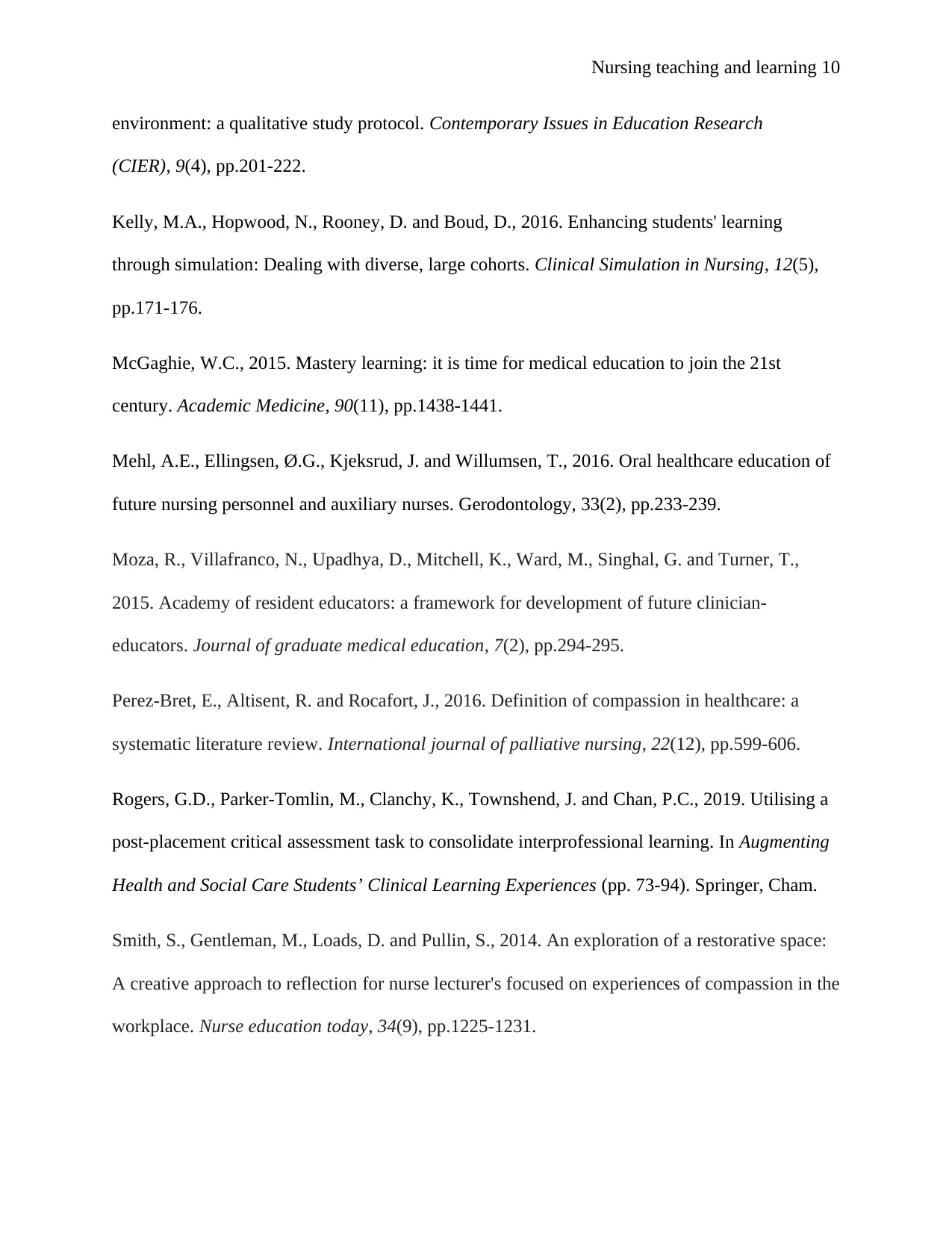
Nursing teaching and learning 10
environment: a qualitative study protocol. Contemporary Issues in Education Research
(CIER), 9(4), pp.201-222.
Kelly, M.A., Hopwood, N., Rooney, D. and Boud, D., 2016. Enhancing students' learning
through simulation: Dealing with diverse, large cohorts. Clinical Simulation in Nursing, 12(5),
pp.171-176.
McGaghie, W.C., 2015. Mastery learning: it is time for medical education to join the 21st
century. Academic Medicine, 90(11), pp.1438-1441.
Mehl, A.E., Ellingsen, Ø.G., Kjeksrud, J. and Willumsen, T., 2016. Oral healthcare education of
future nursing personnel and auxiliary nurses. Gerodontology, 33(2), pp.233-239.
Moza, R., Villafranco, N., Upadhya, D., Mitchell, K., Ward, M., Singhal, G. and Turner, T.,
2015. Academy of resident educators: a framework for development of future clinician-
educators. Journal of graduate medical education, 7(2), pp.294-295.
Perez-Bret, E., Altisent, R. and Rocafort, J., 2016. Definition of compassion in healthcare: a
systematic literature review. International journal of palliative nursing, 22(12), pp.599-606.
Rogers, G.D., Parker-Tomlin, M., Clanchy, K., Townshend, J. and Chan, P.C., 2019. Utilising a
post-placement critical assessment task to consolidate interprofessional learning. In Augmenting
Health and Social Care Students’ Clinical Learning Experiences (pp. 73-94). Springer, Cham.
Smith, S., Gentleman, M., Loads, D. and Pullin, S., 2014. An exploration of a restorative space:
A creative approach to reflection for nurse lecturer's focused on experiences of compassion in the
workplace. Nurse education today, 34(9), pp.1225-1231.
environment: a qualitative study protocol. Contemporary Issues in Education Research
(CIER), 9(4), pp.201-222.
Kelly, M.A., Hopwood, N., Rooney, D. and Boud, D., 2016. Enhancing students' learning
through simulation: Dealing with diverse, large cohorts. Clinical Simulation in Nursing, 12(5),
pp.171-176.
McGaghie, W.C., 2015. Mastery learning: it is time for medical education to join the 21st
century. Academic Medicine, 90(11), pp.1438-1441.
Mehl, A.E., Ellingsen, Ø.G., Kjeksrud, J. and Willumsen, T., 2016. Oral healthcare education of
future nursing personnel and auxiliary nurses. Gerodontology, 33(2), pp.233-239.
Moza, R., Villafranco, N., Upadhya, D., Mitchell, K., Ward, M., Singhal, G. and Turner, T.,
2015. Academy of resident educators: a framework for development of future clinician-
educators. Journal of graduate medical education, 7(2), pp.294-295.
Perez-Bret, E., Altisent, R. and Rocafort, J., 2016. Definition of compassion in healthcare: a
systematic literature review. International journal of palliative nursing, 22(12), pp.599-606.
Rogers, G.D., Parker-Tomlin, M., Clanchy, K., Townshend, J. and Chan, P.C., 2019. Utilising a
post-placement critical assessment task to consolidate interprofessional learning. In Augmenting
Health and Social Care Students’ Clinical Learning Experiences (pp. 73-94). Springer, Cham.
Smith, S., Gentleman, M., Loads, D. and Pullin, S., 2014. An exploration of a restorative space:
A creative approach to reflection for nurse lecturer's focused on experiences of compassion in the
workplace. Nurse education today, 34(9), pp.1225-1231.
Paraphrase This Document
Need a fresh take? Get an instant paraphrase of this document with our AI Paraphraser
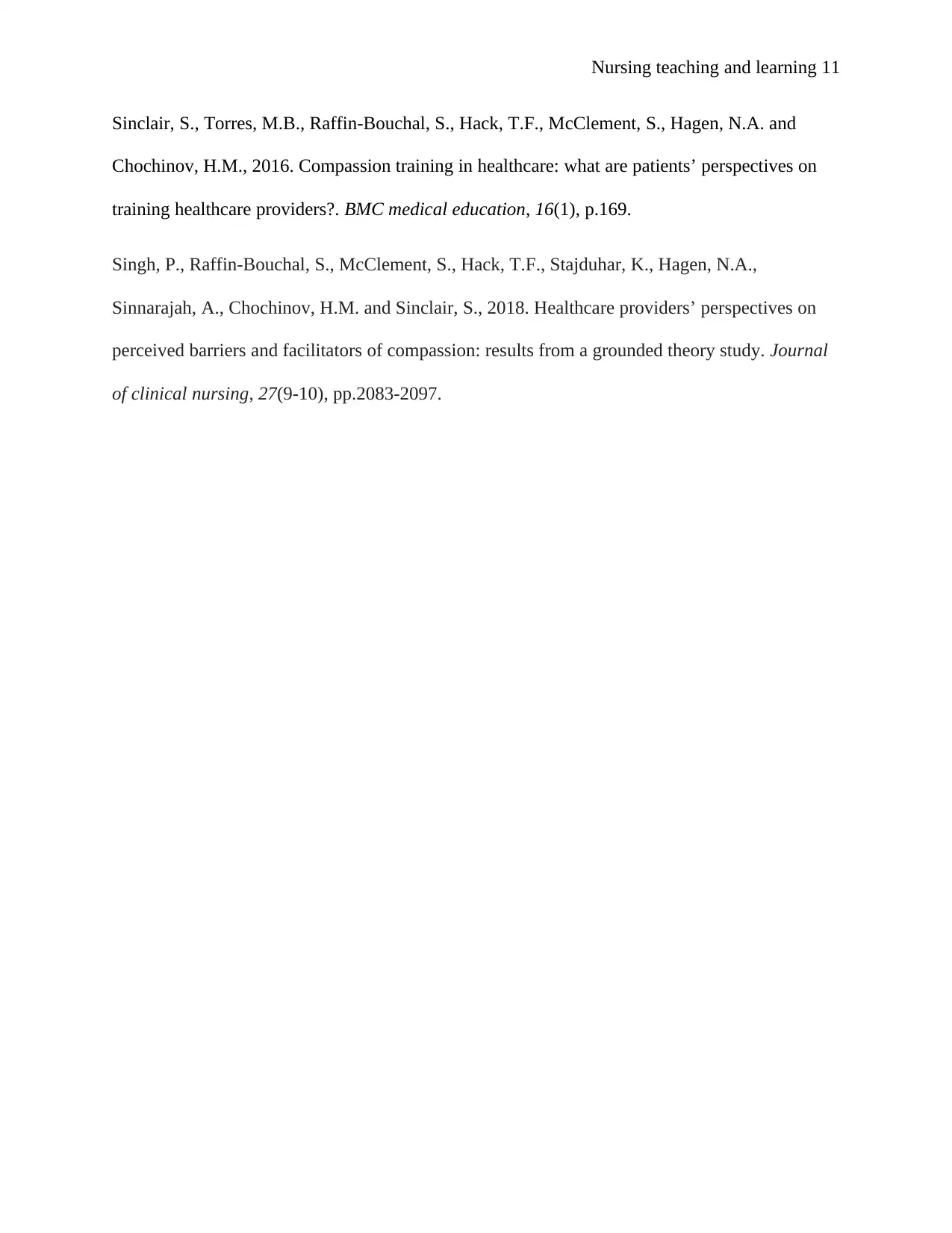
Nursing teaching and learning 11
Sinclair, S., Torres, M.B., Raffin-Bouchal, S., Hack, T.F., McClement, S., Hagen, N.A. and
Chochinov, H.M., 2016. Compassion training in healthcare: what are patients’ perspectives on
training healthcare providers?. BMC medical education, 16(1), p.169.
Singh, P., Raffin‐Bouchal, S., McClement, S., Hack, T.F., Stajduhar, K., Hagen, N.A.,
Sinnarajah, A., Chochinov, H.M. and Sinclair, S., 2018. Healthcare providers’ perspectives on
perceived barriers and facilitators of compassion: results from a grounded theory study. Journal
of clinical nursing, 27(9-10), pp.2083-2097.
Sinclair, S., Torres, M.B., Raffin-Bouchal, S., Hack, T.F., McClement, S., Hagen, N.A. and
Chochinov, H.M., 2016. Compassion training in healthcare: what are patients’ perspectives on
training healthcare providers?. BMC medical education, 16(1), p.169.
Singh, P., Raffin‐Bouchal, S., McClement, S., Hack, T.F., Stajduhar, K., Hagen, N.A.,
Sinnarajah, A., Chochinov, H.M. and Sinclair, S., 2018. Healthcare providers’ perspectives on
perceived barriers and facilitators of compassion: results from a grounded theory study. Journal
of clinical nursing, 27(9-10), pp.2083-2097.
1 out of 11
Related Documents
Your All-in-One AI-Powered Toolkit for Academic Success.
+13062052269
info@desklib.com
Available 24*7 on WhatsApp / Email
![[object Object]](/_next/static/media/star-bottom.7253800d.svg)
Unlock your academic potential
Copyright © 2020–2025 A2Z Services. All Rights Reserved. Developed and managed by ZUCOL.





